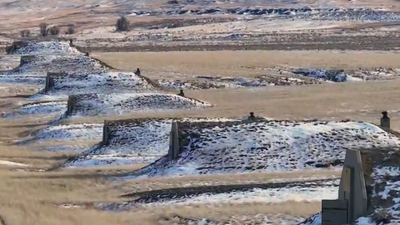
(NewsNation) — Bunkers, survival plans, stocked pantries and stashes of supplies — doomsday preppers have made headlines in the past. But now it’s becoming a big business. Real estate speculators say there are plenty of people concerned enough about the future to buy properties in bunker communities.
In the video above, NewsNation national correspondent Brian Entin visits a former Army base turned bunker community in South Dakota that’s off-grid and built to be self-sufficient.
What is doomsday prepping?
Prepping has been defined as: “The management of stockpiled household items in anticipation of market disruption.”
There are different kinds of preppers out there, including doomsday preppers, climate change preppers, wilderness survivalists and homesteaders. Each have their own preferences and distinctions. Some value the DoomsDay Clock, while others focus more on survival techniques.
Who are doomsday preppers?
Preppers are people who make preparations to survive without government assistance in the event there is a disaster.
Merriam-Webster dictionary defines a prepper as “a person who gathers materials and makes plans in preparation for surviving a major disaster or cataclysm, such as worldwide economic collapse or war.”
In the past year, Finder.com says, 39% of millennials and 40% of Gen Zers reported spending money on prepping. But they’re not the only ones diving into the prepper lifestyle. OpenAI co-founder Sam Altman and celebrities Ryan Seacrest and Josh Duhamel are reportedly into prepping, too.
“We have a lot of ex-military. We have an awful lot of ex-law enforcement. We’ve got people that are teachers, that are telecommuters,” said a representative with Vivos xPoint, the bunker community that NewsNation national correspondent Brian Entin toured in South Dakota.
He continued: “Some people live out here and they telecommute and do their jobs right out of their bunkers. Some people are interested in moving up here. Other people are interested in having a place to bug out to.”
How do doomsday preppers prepare?
Roughly a third of the adult U.S. population reportedly dropped $11 billion in the past year or so on emergency preparedness.
Investing into savings accounts, home renovations and stashing cash are the most costly prepper activities, while stocking up on food and water is the most popular, a study said.
At Vivos xPoint, some people have a plane full of gas to get them to their bunkers at any moment. Some of the bunkers have generators, a bomb blast door, gun safes, an electrical room and storage for food, along with bedrooms and bathrooms.
The South Dakota property of more than 530 bunkers is built to be self-sufficient. Out of all the $55,000 bunkers on site, about 200 have sold and sales have been picking up.
When did prepping start?
According to Merriam-Webster, the first known use of “prepper” was in 1904, but early roots of the prepper movement have been traced back to around the time of the Cold War in the 1950s. Modern-day preppers emerged after criticized disaster responses to Hurricane Andrew in 1992 and Hurricane Katrina in 2005.
While prepping still seemed a bit unconventional, the COVID-19 pandemic made it more mainstream for people to stock up on essentials and form their own survival kits.
“Do I think prepping is here to stay? Absolutely. But I’d argue it was already mainstream but had a stigma. People weren’t talking about it. We’re all preppers now,” Anna Maria Bounds, a sociology professor studying urban preppers, told National Geographic in 2020.
Someone at Vivos xPoint told Entin that crime has been a driver for people looking into prepping lately.
“There’s a lot of things out there that you could be worried about. I think the biggest thing is you go to big towns and the amount of crime and everything that goes on, you’re really not safe anymore,” he said.
Many countries in the world, including the U.S., advise people to prepare to survive for three days without assistance from authorities in the case of an emergency.
As far as the popularity of the practice goes, Finder.com says nearly 30% of surveyed Americans reported taking steps toward emergency preparedness in 2022, which represents roughly a 25% increase compared to 2017.